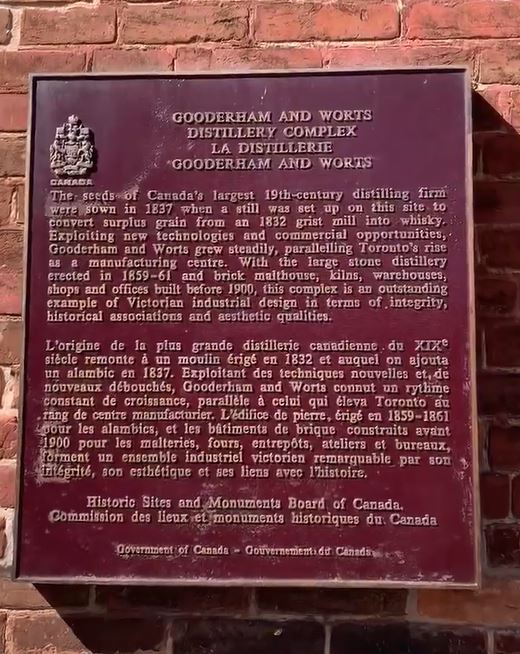Gooderham and Worts Distillery National Historic Site

© Parks Canada, 2022
Gooderham and Worts Distillery was designated a national historic site in 1988.
Commemorative plaque: Trinity Street, Toronto, OntarioFootnote 1
The seeds of Canada's largest 19th-century distilling firm were sown in 1837 when a still was set up on this site to convert surplus grain from an 1832 grist mill into whisky. Exploiting new technologies and commercial opportunities, Gooderham and Worts grew steadily, parallelling Toronto's rise as a manufacturing centre. With the large stone distillery erected in 1859-61 and brick malthouse, kilns, warehouses, shops and offices built before 1900, this complex is an outstanding example of Victorian industrial design in terms of integrity, historical associations and aesthetic qualities.
Description of historic place
The Gooderham and Worts Complex includes 30 brick and stone industrial buildings, some of which are attached to one another, located on 13 acres of land at the intersection of Trinity and Mill streets on the eastern edge of downtown Toronto. The buildings were constructed between 1859 and 1927 to produce, package, store, market and develop spirits for the Gooderham and Worts firm. The formal recognition consists of the buildings on their property at the time of designation.

© Parks Canada, 2022

© Parks Canada, 2022

© Parks Canada, 2022
Heritage value

© Parks Canada
The Gooderham and Worts Complex was designated as a site of national historic and architectural importance because: it is an imposing landmark, containing a number of buildings that collectively bear witness to the evolution of the Canadian distilling industry.
The heritage value of the Gooderham and Worts Complex resides in the unique sense of history and place created by: the completeness of the complex in illustrating the entire distillery process, from the processing of raw materials, to the storage of finished products for export; the physical evidence that it provides about the history of Canadian business, the distilling industry and 19th-century manufacturing processes; the architectural cohesiveness of the site characterized by a high degree of conformity in the design, construction and craftsmanship of its constituent buildings; and the physical relationships among the buildings and between the site and the railway to the south.
Source: Historic Sites and Monuments Board of Canada, Minute, 1988.
The National Program of Historical Commemoration relies on the participation of Canadians in the identification of places, events and persons of national historic significance. Any member of the public can nominate a topic for consideration by the Historic Sites and Monuments Board of Canada.
- Date modified :